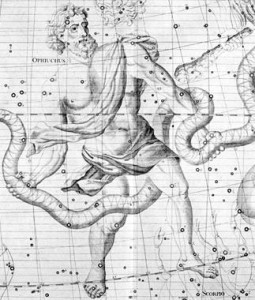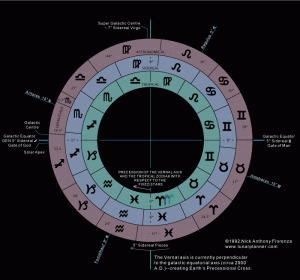 This is a continuation of a continuation. You can board this train of thought by reading earlier posts here.
This is a continuation of a continuation. You can board this train of thought by reading earlier posts here.
Ok, so last time, I think I may have gotten off on a bit of a tangent. No biggie. Let’s see if we can get back to our question and reel this thing in. “What’s an Ophiuchus?”
Well, Ophiuchus is a constellation in our western sky culture. The associated image depicts a snake bearer. The snake itself is actually depicted in a neighboring constellation called Serpens. Ophiuchus is just the dude part of the image.
Ok, so what does this have to do with the Zodiac? Well, when we look at the constellations along the ecliptic, it’s like looking at a big group photograph. Most descriptions of this photograph count 12 people. But some people look at the photograph and say “What about that guy?! That guy right there?!”
Everyone squints and says “What are you talking about? Do you mean that foot?”
“Yes, that’s someones foot. So, technically there’s 13 people in this photograph.”
“Ok, Captain Anal. Sure there’s a foot in there. It’s Ophiuchus’ foot. But, he’s not really part of the club. He’s a bystander who’s foot got in the frame.”
“Why isn’t he part of the club? I mean he’s on the line, isn’t he? He should be part of the club!”
If you’ve been reading with me this far you know that the conceptual signs don’t line up with the physical constellations. (If you didn’t know that, return to part 1, do not pass go, do not collect $200.)
Lost Observer: “I thought the Sidereal Zodiac did line up with the constellations. This is what I was led to believe.”

So, we’ve got two Zodiacs, the Tropical and the Sidereal. Then out of nowhere, the aforementioned Captain flies in and says “Why can’t we have a zodiac that actually matches the boundaries of the constellations?”
I have seen this third type of Zodiac referred to as the Constellational Zodiac, the real Zodiac, and/or the Galactic Zodiac.
Here’s where traditional people start freaking out, Tropical practitioners and Siderealists, alike. They shout and stamp their feet and say “No! No! No!, We have always done it this way, we will always do it this way! Your idea frightens us because it challenges our comfortable paradigm.”
Behind all the noise, the more stoic astrologer will quietly note that the Constellational Zodiac is not very practical (yet) and that is the real reason it is unpopular. See, the number 12 is a very elegant number. It is easily divided by 1, 2, 3, 4, 6, and itself. It is easier to work with than the number 13 which can be divided by, er, um, 1 and 13. Also, the divisions are all different sizes. I’ll say it again, the actual constellations are not all evenly spaced across the sky. For example, in the Constellational Zodiac the boundaries of Taurus are about 5and a half times farther apart than Scorpio. Scorpio is just a tiny sliver of the pie. Mathematically speaking, that’s a pain in the a… Or is it?
There was a time when to get into astrology, you had to be good at math. Charts were all drawn by hand. Complex calculations were made with fingers, ropes, beads, or more recently pencil on paper. But now we have machines. Computers can do all the heavy mental lifting for us. The idea that a number has fewer factors really shouldn’t wig us out anymore.
Do I think the Constellational Zodiac will replace the other zodiacs? No. Do I think it has a place as an alternative point of view, one that marks a shift in our consciousness about our place in the cosmos, just like the divide between the Sidereal and Tropical Zodiacs did? You bet.
If you just got a handle on your current chart and all that seems like too much to consider, don’t worry. There are plenty of Uranian types out there right now hacking away at this relatively new frontier of conceptualizing our universe, so you don’t have to yet. And about 5 percent of them are Ophiuchians (that is, if they even care to define themselves in such egoistic terms as the sun sign.)
I think I may have come to a good stopping place. Unless someone throws out a good question or two. Anyone?


This is a good series and enjoyable Nota. What I try to teach students about Astrology and these systems is that all can be applied, and quite well by those who gain a firm grasp and understanding of the skies themselves.
Most of these arguments, within Astrology, over the past 30 years (since the 1980s) has been among Secular practitioners of astrology; many of whom came to astrology late in life and have gaps in their knowledge.
I always avoided the secular approach because I found it quite narrow-minded, and frankly, those “astrologers” could not forecast.
Moreover, those who were most stringent did not like to forecast and had problems with astrological forecasting to the point of saying that those who did forecast were using “predictive astrology” – as if their astrology were somehow outside of forecasting?
I found that very very odd, considering that Astrology is, in fact, priori-based – a forecasting science.
It is not a surprise some are confused over the Sidereal and Tropical systems, as many of those people calling themselves “astrologers” fail to observe the actual heavens. Some cannot identify a planet on sight, which is pitiful.
The word “sidereal” means “according to the stars,” and to observe. As an expert astrologer, I use all techniques as a whole, and do not have a philosophy built into one technique over the another – that is secular and non-inclusive.
It is also very short-sighted considering the history of Astrology.
“Tropical” against “Sidereal” against “Uranian,” and all the other secular wars are unhealthy forms of philosophy, and it is exactly that kind of ideology which causes much confusion to the student where there need be none.
The constellational zodiac can be used by anyone practicing astrology, and is very helpful to read horoscopes and to make advanced forecasts.
But constellational astrology applies both tropical and sidereal systems, which includes usage of the fixed stars in delineating personal horoscopes.
There is always more to learn, but where you will find Secular “astrologers,” you will find those who cover up major gaps in their knowledge with ideological arguments pitting one technique and/or system against the another.
Astrology is all-inclusive, as the techniques and systems used by the astrologer are applied with interdisciplinary and holistic precision which offer fine results for the practitioner who is non-secular, thus not prone to major errors because of ideology.
Enjoying your series Nota. Keep up the good work!
Wonderful series! Very informative! *claps*
Question? Um, why 5%? The foot?
So Nota, are you positing that the Constellational Zodiac is only ineffective because a ‘Uranian type’ hasn’t perfected it? If so, wouldn’t the C.Z. then be just as valid as the more popular systems? Kind of like not believing Pythagoras until Columbus came back? I wonder these things only because if it is in fact equally relevant, wouldn’t it benefit us all to give it some credence?
@JerriAtTricks (love your handle!): Exactly! This whole celestial shenanigan feels like cusp issues..
Jeri,
Ophiuchus covers about 18.5 degrees of the ecliptic. Assuming that all else is equal, that makes roughly 5% chance of being born under Ophiuchus.
Lolo,
Any system is only as effective as the individual who employs it. I was being a bit tongue in cheek when I said a “Uranian” would do it for you, implying that they are more forward thinking/advanced. Yes, this system is just as valid as any other. I think it is not as popular because it takes more skill/discipline and then gets labeled as impractical because it seems inaccessible.
I also don’t think it is really something everyone needs to pay attention to unless they have the interest. I think it would behoove any student who is genuinely interested to study, but other than that, fuck it. Astrology is an esoteric Science/art.
Some of it is not totally accessible to everyone.
Theo,
Thanks. That means a lot coming from you. I read your recent blog on the topic. Good stuff. Anyone who wants something meatier than what I’m doing here, I recommend taking a look:
http://globalastrologyblog.blogspot.com/2011/01/cardinal-crisis-astrological-forecast.html
Truly rare to find qualified persons about this issue, you be understood as you are aware of exactly what you are posting about! Cheers